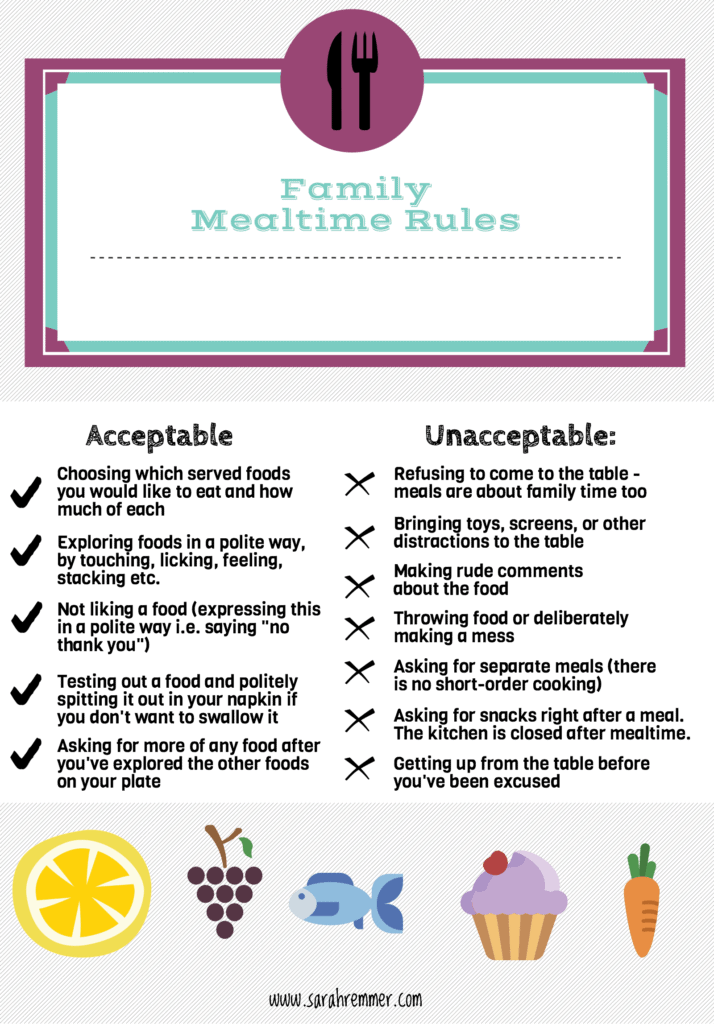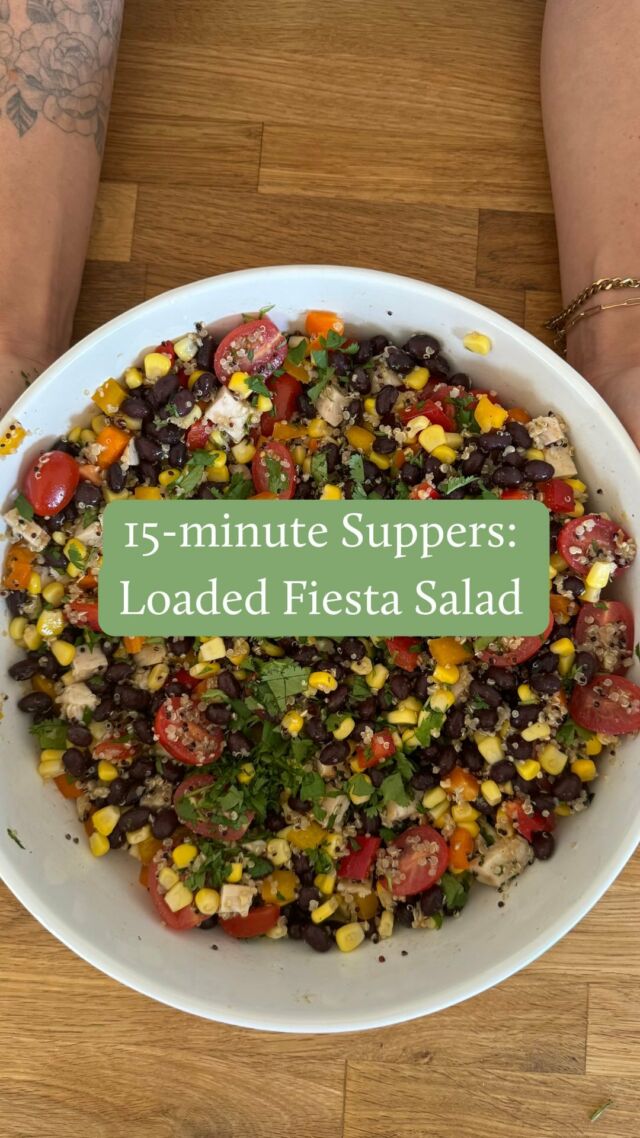As the parent of a preschooler and baby, I know firsthand how stressful mealtimes can be. They are certainly not relaxing by any stretch of the imagination, but they can be enjoyable and less chaotic if boundaries are set.

It’s up to us parents to set these boundaries and consistently enforce them, while at the same time, letting our kids explore food in a fun and unpressured way.
Minimize picky eating and mealtime battles by setting these mealtime boundaries with your kids:
You set the timetable:
As a parent, you get to decide when mealtimes happen. Otherwise, eating becomes a food free-for-all and a snack-fest all day long. When this happens, kids often refuse to eat at meal times (because they’re full from snacking) and this makes mealtime unenjoyable for all. One of the things that I love about Ellyn Satter’s Division of Responsibility, is that it takes the pressure off of both the parents and the kids when it comes to mealtime. Parents are responsible for the what’s, where’s and when’s of eating and then kids get to decide whether and how much they eat. This can be scary for parents because it means that the control is handed over to their kids after the meal has been served. But once parents can let go and trust that their child will learn to accept most foods in time, this no-pressure way of feeding lifts a huge weight off of their shoulders. Parents already carry the burden of planning meals and snacks, shopping for and preparing food, so when the responsibility of making sure your child actually eats is shifted from the parent to the child, parents often feel a sense of relief. As they should.
The 5 minute warning:
Give your child a 5 minute warning for mealtime. When kids are focused on building a Lego kingdom or pillow fortress, or deep into a puzzle, they will likely react negatively (to put it nicely) when Mom or Dad insists that they stop NOW and come to the table NOW. It’s just not that easy for toddlers, preschoolers and young kids to switch gears that quickly. Giving them a 5 (and then 3,2 and 1) minute warning allows them to finish up what they are doing, clean up and come to the table.
The magic mealtime words:
When your child resists (even with the warning) to come to the table, saying “but I’m not hungry!” or “I don’t want to have dinner!”, you can simply say “you do not have to eat“. It may seem counter-intuitive to say these words, but it will make your life a lot easier. It takes the pressure off your child, you likely dodge a mealtime battle. And as a bonus, 9 times out of 10, your child will eat once they’ve sat down with the rest of the family. You are setting a boundary in that your child must sit at the table, but you are taking the pressure off by leaving it up to them as to whether they eat and how much they eat. The ball is then in their court. Make sure that you include one or two foods that you know that your child likes–that way, he or she will have something to eat even if they don’t like (or aren’t ready to try) other foods. Including a familiar and accepted food also makes it less scary to try a new unfamiliar food alongside it.

It’s not all about food:
If your child refuses to eat with the rest of the family for whatever reason, tell him or her that it is ok, but they must stay seated at the table. Teach your kids that mealtimes aren’t just about eating food, but also connecting with the rest of the family. Mealtimes are an opportunity for kids to tell you about their day (and vice versa), to observe you eating (which gives you a chance to model healthy eating), and to connect with the rest of the family. We set the 10 minute rule in our house which means our preschooler must stay at the table for at least 10 minutes before being excused. Once he’s excused, there’s no returning to the table to eat.
Decide what’s acceptable and what’s unacceptable:
Decide what is “acceptable” behaviour and “unacceptable” behaviour at the table and stick to it. In our home, acceptable behaviour is saying “no thank you” if food is turned down, tasting food and if it’s a no-go, politely spitting it out in a napkin, eating with hands if the food is a “finger food” and using utensils when it’s not (or at least giving it a good go), playing with food to explore (stacking, feeling, organizing, separating etc.). Unacceptable behaviour is throwing/flinging, leaving the table too soon (before ~5 minutes for toddlers, and before ~10 minutes for preschoolers), bringing toys to the table, saying negative things about the food served, being rude, yelling and getting up and down from the table over and over again. The most important thing is that you stay consistent with your mealtime expectations so that your kids know what is acceptable and what is not.

Give warning about future eating opportunities:
It’s easy to fly by the seat of your pants when it comes to eating (and feeding), especially when life gets busy. Meals and snacks often get served when time allows, in the car, in front of the TV or in bedrooms. Sometimes it’s just easier to give in when your child says “I’m hungry, can I have a snack?” to avoid confrontation or a tantrum. When it happens regularly, main meals tend not to be eaten. This could be because your child is too full from snacking before the meal, and/or because they are holding out for future snacks later on.
When my son was younger, we got into the bad habit of offering a bedtime snack every night, regardless of what time dinner was eaten. So even if dinner wasn’t served until 6:30pm (and my son goes to bed at 7:30pm), he would still get a snack. What started to happen is that he would eat less and less of his dinner, knowing that yogurt and berries, banana and peanut butter or something else familiar and yummy was coming before bed. We’ve started making a point of letting him know whether or not there will be a snack before bed (depending on timing) and it has helped. We either say “the next time you will have a chance to eat isn’t until tomorrow’s breakfast” or “the next chance to eat is right before story time”. If your child asks for a snack an hour later, remind them by saying “remember when I told you that your next chance to eat isn’t until before story time? That’s when you will get a chance to eat again. This is in 2 hours. The kitchen is closed until then. ” Or something along those lines.
It’s important that we give our growing children ample eating time and opportunities (about every 2-3 hours), but it’s also important to set boundaries so that eating doesn’t become a food free-for-all.
If you found this helpful, you may also like this post on how to avoid common mealtime battles and this one on what and how much you should be feeding your toddler.









Comments
Jessica says
Hi there I need some help! My kids are 12 and 14 and meal times are a lot more fun when dad isn’t home. He’s not really conversational (holds a STRONG belief that you should not ever laugh at the dinner table) but the hardest part is he gets upset with the kids for sitting too close or too far from the table, to sit up “properly” and there’s this negative energy around how the meal time should be. We are working on all our relationship issues and things have been improving so these moments make my stomach drop.
I would say he does like to be in control and this is one of those ways it comes out. So WHAT if they’re not sitting up perfectly?! I want joy and love and grace to fill this home! Plus he was scraping every last bit off his bowl last night – also not proper! I I did mention it later saying we need to let go of some stuff and you can imagine how that went.
They’re new teens and I don’t want them to remember meal time as being told and then the anger and latent frustration of it all.
Help!!
Sarah Remmer says
Hi there Jessica! First of all, I’m sending you so much compassion right now during this difficult time. Mealtimes should be relaxed and not anxiety-inducing. It’s so hard when both parents do not have the same values. I get that! I am hosting a Mealtimes Solved challenge this month. We will be covering this topic. Are you on my emailing list? If not, please subscribe and more information will be coming to your inbox about the launch soon! You can always contact me here for more info! https://www.sarahremmer.com/contact/
Sally says
Hi I have 3 children 11,9 and 6.
Super fussy eaters all of them, feel like they control what they appear, often I have to make 3 different meals as they decide that they all want different food! I’ve tried to stop this and only cook one meal but that ends up in a bin, they are happy to go without food rather than back down.
It all sounds easy on here but I tried and failed, no results. What to do when they’re so stubborn?
Thanks
Sarah Remmer says
I feel you Sally. Kids can be so stubborn! The biggest thing to remember (and repeat) is “it’s not YOUR job to get your kids to eat”. It’s your job to provide the food, and it’s your kids job to decide IF they eat it and HOW MUCH. Short order cooking is giving them control over WHAT is offered – and that’s your responsibility. There are some strategies to help them learn to accept new food and be brave when trying new things – like enlisting their help in the kitchen, offering a familiar food, etc. I’d be happy to help you explore these options. Feel free to reach me directly at lesley@sarahremmer.com. But rest assured, your kids will eventually eat 🙂
Peggy says
I’m new to your blog. Mealtimes were so stressful before I learned the division of responsibilities. There was a time when I would burst into tears at the dinner table from worry and frustration. Now my child is 5 years old. He is still choosy but has definitely expanded his palate. Mealtimes are much more enjoyable for the whole family. Thanks for your great tips! I love reading you posts.
Sarah Remmer says
This makes me so happy to hear. Thank you!
Melissa Siegel says
This is our house right now! Some of these things we are working on. It isn’t easy!
sarahrem says
I hear you! It’s not easy at all, but hopefully some of these tips will help 🙂
Sara Villamil says
Absolutely beautiful new blog!
sarahrem says
Thanks Sara!!